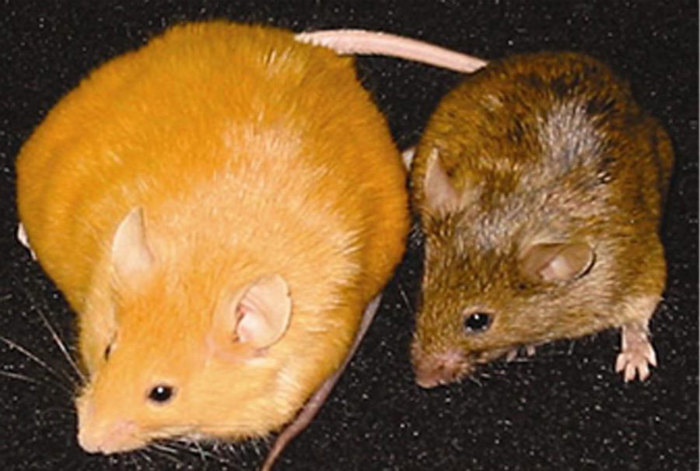
Are surrogate children genetically related to the birth mother?
July 26, 2006

- Related Topics:
- Reproduction,
- Microchimerism,
- Epigenetics,
- Developmental biology
A curious adult from California asks:
“Do surrogate children share any genes with the birth mother? Is there any genetic relationship of these children to the surrogate? Is there a health relationship to this mother?”
That is an interesting question that I hadn’t thought too much about before. I'm assuming you are asking about gestational surrogacy, where a fertilized embryo is implanted in a woman who is not otherwise related to the child. (There are some other types of surrogacy, which we won’t get into here.)
In essence, your question becomes whether a baby’s DNA can be changed during pregnancy. The answer is that sometimes it can. But usually these are very small changes that are hard to detect. The baby is still genetically related to their biological parents, not the surrogate.
But pregnancy does affect the baby, sometimes in permanent ways. Let’s dive into the details on what we know about this.
Lasting epigenetic changes
How could you tell if pregnancy affected the child? One way would be if the effect were passed down again. In other words, you would see the effect in the grandkids too.
We don’t know how common this sort of thing is. But there are examples that show that grandkids can be affected by what grandma did. Or even grandpa!
For example, at the end of World War II, parts of the Netherlands suffered from famine. As one might expect, babies born at this time were much smaller and suffered from various health problems.
What was unexpected was that their grandkids were smaller too. This means that whatever changes happened could be passed down to the next generation. This almost always involves DNA.
In an unrelated case in Scandinavia, scientists showed that what grandma or grandpa ate affected whether their grandkids would get diabetes. Again, diet is apparently affecting the DNA.

So how might this work? How can the environment make a predictable change in the DNA because of something that happens to mom?
Well, it probably wouldn’t change the order of A, C, G, and T’s that make up the instructions found in DNA. These instructions aren’t likely to be changed in such specific ways. But what might be happening is that parts of the DNA are being covered up so that certain genes can’t be read by the cell.
Before going into how this might happen, we need to first go over what genes are and how they work. Genes are pieces of DNA that are instructions for making a protein. These proteins go on to be involved in almost everything from breathing to thinking to deciding how tall you can be.
In order for a gene to be used, the instructions it contains need to be read by a cell. And the cell needs to make the protein from the instructions.
This is like the instructions for putting a bike together. If no one reads and follows the directions, you end up with a piece of paper and a bunch of bike parts. If the cell doesn’t read the gene, you have a bunch of DNA and protein parts.
A cell reads a gene using certain proteins that copy the instructions from the DNA into RNA. These proteins “see” the start of a gene by looking for a certain sequence of DNA letters. Sort of like capitalizing the first word of a sentence.
What diet (and other environmental factors) might do is hide these sequences from the cell, sort of like uncapitalizing a letter in a sentence. This can happen by sticking something called a methyl group to the DNA.
The methyl group covers up the start of the gene so the cell can’t see it. To the cell, a methylated gene isn’t there anymore. And we know that methylated DNA can be passed on to our kids.
We also know that genes are affected in people by methylation (click here to learn about methylation and identical twins). But we don’t know if this is what happened in our two European examples. There is an example in mice, though, where we do know that what mom ate affected the methylation of the DNA of her pups.

Scientists found that if you fed a pregnant mouse one kind of food, she had yellow pups. A different kind of food resulted in black pups.
These pups all had the same genes but some were yellow and some were black. And the black moms had black babies and the yellow moms had yellow babies. What the pregnant mom ate had a long lasting effect on which genes were on in her pups and her grandpups.
These yellow mice also suffered from a higher risk for obesity and diabetes. This increased risk was passed down to their kids along with the yellow hair.1
So what a mother does can change how a child’s DNA gets used. Again, we don't know how common this is; only that it can happen.
Swapping cells: microchimerism
But can mom add DNA to the child later in development? The answer is, well, kind of. Over time, a mother and fetus can sometimes exchange cells.
Scientists didn’t used to think this was very common. But more recent data suggests that it happens much more often than they previously thought. (This is called microchimerism – click here to learn more about chimerism.)
If the cells exchanged are stem cells, then they will take root in the fetus and produce cells even into adulthood. For example, if blood stem cells are transferred, then a child with one blood type may contain a few cells of another type.
How much effect this has on a child is unclear. Some researchers are investigating whether some health conditions can be triggered from effects like these. This is all still preliminary though.
It is important to note that what we are talking about here is not specific to surrogate mothers – these are things that happen with all mothers and their children. I also want to note again that we don’t know how common it is that what a mother does can predictably change a child’s DNA.
We only know that it can and does happen. Changing DNA predictably because of something in the environment is called epigenetics. This field was in the backwaters of science for a long time.
But as evidence mounts that it happens more often than they thought and that it is important, epigenetics is getting more and more studied. Now, how much of this sort of thing happens from mother to child is anybody’s guess. We'll know a lot more about these sorts of things in the years to come.

Author: Dr. Barry Starr
Barry served as The Tech Geneticist from 2002-2018. He founded Ask-a-Geneticist, answered thousands of questions submitted by people from all around the world, and oversaw and edited all articles published during his tenure. AAG is part of the Stanford at The Tech program, which brings Stanford scientists to The Tech to answer questions for this site, as well as to run science activities with visitors at The Tech Interactive in downtown San Jose.
 Skip Navigation
Skip Navigation
